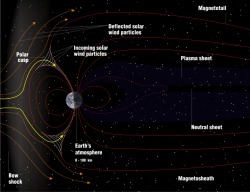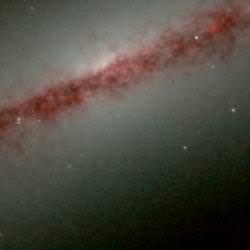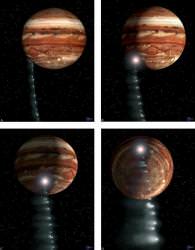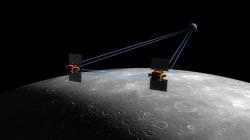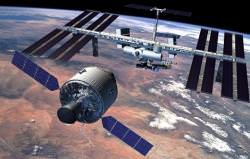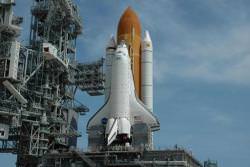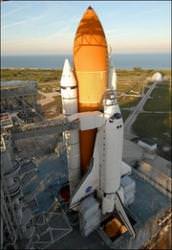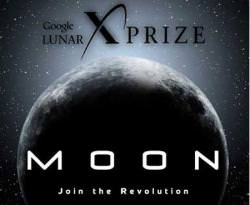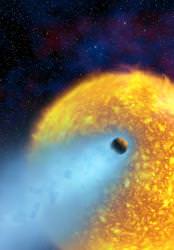Monday, December 10 – If you are out stargazing until the morning hours, look for the peak of the Monocerid meteor shower. Its fall rate is around one per hour and its radiant point is near Gemini.
Tonight let’s go north for a mid-size scope challenge about two fingerwidths east-northeast of the beautiful double star Gamma Andromedae (RA 02 22 32.90 Dec +43 20 45.8).
The 12th magnitude NGC 891 is a perfect example of a spiral galaxy seen edge-on. To the mid-sized scope, it will appear as a pencil-slim scratch of light, but larger telescopes will be able to make out a fine, dark dust lane upon aversion. Discovered by Caroline Herschel in 1783, NGC 891 contained a magnitude 14 supernova event recorded on August 21, 1986. Often considered a “missed Messier,” you can add this one to your Caldwell list as number 23!
Tuesday, December 11 – On this date in 1863, Annie Jump Cannon was born. She was a United States astronomer who created the modern system for classifying stars by their spectra. Why not celebrate this achievement by coming along with me and viewing some very specific stars that have unusual visual spectral qualities! Let’s grab a star chart, brush up on our Greek letters and start first with Mu Cephei.
Nicknamed the “Garnet Star,” this is perhaps one of the reddest stars visible to the unaided eye. At around 1200 light-years away, this spectral type M2 star will show a delightful blue/purple “flash.” If you still don’t perceive color, try comparing Mu to its bright neighbor Alpha, a spectral type A7, or “white,” star. Perhaps you’d like something a bit more off the beaten path? Then head for S Cephei about halfway between Kappa and Gamma toward the pole. Its intense shade of red makes this magnitude 10 star an incredibly worthwhile hunt.
To see an example of a B spectrum star, look no further than the Pleiades… All the components are blue white. Want to taste an “orange?” Then look again at Aldeberan, or Alpha Tauri, and say hello to a K spectrum star. Now that I have your curiosity aroused, would you like to see what our own Sun would look like? Then choose Alpha Aurigae, better known as Capella, and discover a spectral class G star that’s only 160 times brighter than the one that holds our solar system together! If you’re enjoying the game, then have a look at a star with one of the most unusual spectra of all – Theta Aurigae. Theta is actually a B class, or a blue/white, but instead of having strong lines in the helium, it has an abnormal concentration of silicon, making this incredibly unusual double star seem to glitter like a “black diamond.”
Still no luck in seeing color? Don’t worry. It does take a bit of practice! The cones in our eyes are the color receptors and when we go out in the dark, the color-blind rods take over. By intensifying the starlight with either a telescope or binoculars, we can usually excite the cones in our dark-adapted eyes to pick up on color.
Tonight is also the peak of the Sigma Hydrid meteor stream. Its radiant is near the head of the Serpent and the fall rate is also 12 per hour – but these are fast!
Wednesday, December 12 – Today in 1961, OSCAR-1 was launched. The project started in 1960; the name stands for Orbital Satellite Carrying Amateur Radio. OSCAR-1 operated in orbit for 22 days, transmitting a signal in Morse Code – the simple greeting “Hi.” The success of the mission helped to promote interest in amateur radio which still continues to this day!
Tonight before the Moon interferes with fainter studies, let’s head far north for one of the oldest galactic clusters in our visible sky – NGC 188.
Hovering near Polaris (RA 00 44.5 Dec +85 20) this circumpolar open cluster also goes by other names: Collinder 1 and Melotte 2. Discovered by John Herschel on November 3, 1831, this 8th magnitude collection of faint stars will require a telescope to resolve its 120 members. At one time, it was believed to be as old as 24 billion years, later updated to 12 billion; but it is now considered to be around 5 billion years old. No matter how old it may truly be, it is one of the time-honored great studies and is also number one on the Caldwell list!
Thursday, December 13 – Today in 1920, the first stellar diameter was measured by Francis Pease with an interferometer at Mt. Wilson. His target? Betelgeuse!
Tonight will being be one of the most hauntingly beautiful and most mysterious displays of celestial fireworks all year – the Geminid meteor shower. First noted in 1862 by Robert P. Greg in England, and B. V. Marsh and Prof. Alex C. Twining of the United States in independent studies, the annual appearance of the Geminid stream was weak initially, producing no more than a few per hour, but it has grown in intensity during the last century and a half. By 1877 astronomers realized a new annual shower was occurring with an hourly rate of about 14. At the turn of the century, it had increased to over 20, and by the 1930s up to 70 per hour. Only eight years ago observers recorded an outstanding 110 per hour during a moonless night… And our Moon will soon set!
So why are the Geminids such a mystery? Most meteor showers are historic – documented and recorded for hundred of years – and we know them as being cometary debris. When astronomers first began looking for the Geminids’ parent comet, they found none. It wasn’t until October 11, 1983 that Simon Green and John K. Davies, using data from NASA’s Infrared Astronomical Satellite, detected an orbital object (confirmed the next night by Charles Kowal) that matched the Geminid meteoroid stream. But this was no comet, it was an asteroid.
Originally designated as 1983 TB, but later renamed 3200 Phaethon, this apparently rocky solar system member has a highly elliptical orbit that places it within 0.15 AU of the Sun about every year and half. But asteroids can’t fragment like a comet – or can they? The original hypothesis was that since Phaethon’s orbit passes through the asteroid belt, it may have collided with other asteroids creating rocky debris. This sounded good, but the more we studied the more we realized the meteoroid “path” occurred when Phaethon neared the Sun. So now our asteroid is behaving like a comet, yet it doesn’t develop a tail.
So what exactly is this “thing?” Well, we do know that 3200 Phaethon orbits like a comet, yet has the spectral signature of an asteroid. By studying photographs of the meteor showers, scientists have determined that the meteors are denser than cometary material and not as dense as asteroid fragments. This leads us to believe that Phaethon is probably an extinct comet that has gathered a thick layer of interplanetary dust during its travels, yet retains the ice-like nucleus. Until we are able to take physical samples of this “mystery,” we may never fully understand what Phaethon is, but we can fully appreciate the annual display it produces!
Thanks to the wide path of the stream, folks the world over get an opportunity to enjoy the show. The traditional peak time is tonight as soon as the constellation of Gemini appears around mid-evening. The radiant for the shower is right around bright star Castor, but meteors can originate from many points in the sky. From around 2 am tonight until dawn (when our local sky window is aimed directly into the stream) it’s possible to see about one “shooting star” every 30 seconds.
The most successful of observing nights are ones where you are comfortable, so be sure to use a reclining chair or pad the ground while looking up. Please get away from light sources when possible – it will triple the amount of meteors you see. Enjoy the incredible and mysterious Geminids!
Friday, December 14 – Today was a very busy day in astronomy history. Tycho Brahe was born in 1546. Brahe was a Danish pre-telescopic astronomer who established the first modern observatory in 1582 and gave Kepler his first job in the field. In 1962, Mariner 2 made a flyby of Venus and became the first successful interplanetary probe. As we begin our evening on the Moon, be sure to check with IOTA for a possible occultation event in your area. Neptune is less than a degree away to the north!
On this day in 1972, the last humans (so far) to have walked on the lunar surface returned to Earth. Eugene Cernan left the final bootprint at Taurus-Littrow and called it the “end of the beginning.” As we reach the end of our observing year, let this only be the beginning for you as we look to that distant orb to seek out the Apollo 17 landing area.
You have learned so much over the last 12 months! Even if the terminator has not progressed as far as the illustration shows, you should know the approximate location of Posidonius on the surface and recognize Mare Crisium and the Taurus Mountains to its east as well as the small, grey expanse of Sinus Amoris between them. Littrow is on its western shore, and although it is rather small with a 31 kilometer diameter, Mons Vitruvius will shine like a beacon to the south.
Enjoy your Moon walk!
Saturday, December 15 – Today in 1970, the Soviet spacecraft Venera 7 registered a first as it made a successful soft landing on Venus, and so went into the history books as the first craft to land on another planet. You can catch Venus yourself in the pre-dawn skies!
Tonight, one of the most outstanding features on the lunar surface will be the southern crater Maurolycus. Although we have visited it before, look again! At an overall diameter of 114 kilometers, this double impact crater sinks below the surface to a depth of 4730 meters and displays a wonderful multiple mountain-peaked center. If you have not collected Gemma Frisius for your studies, you will find it just north of this grand crater, looking much like a “paw print” at low power.
Now let’s travel 398 light-years away as we have a look at AR Aurigae – the centermost star in a brilliant collection. It is about one-third the distance from southern Beta to northern Alpha (Capella). AR is an eclipsing binary which consists of two main sequence white dwarf stars. About every 4.1 days, this pair will make a slight magnitude drop. While both are chemically peculiar, neither fills its Roche Lobe – meaning they are not stripping material from each other to cause these unusual abundances. Recent studies have shown the possibility of a third, unseen companion! But even binoculars will see that AR resides in a great field of stars and is worth a little of your time…
Sunday, December 16 – With only nine days left until the holiday, astronomers have recently discovered a unique feature on the lunar surface. While accepted for many years to be a natural feature of selenography, modern photography coupled with today’s high powered telescopes have discovered an area near the lunar North Pole that’s being used as a runway by a man in a red suit piloting an unusual spacecraft. Be sure to spark the imaginations in your young viewers as you show them the Alpine Valley!
Today we celebrate the birthday of Edward Emerson (E. E.) Barnard. Born in 1857, Barnard was an American observational astronomer and an absolute legend. He led a very colorful life in astronomy, and his sharp skills have led to a multitude of discoveries. His life was a very fascinating one: Barnard was often known to simply set the scope on one point in the sky and just watch for new objects as the field moved! Tonight let’s take a look at a bright star that has Barnard’s touch, as we explore Beta Aurigae – Menkalinan.
First identified as a spectroscopic binary by A. Maury in 1890, Beta itself is part of a moving group of stars that includes Sirius, and is an Algol-type variable. While you won’t see changes as dramatic as those of the “Demon Star,” it has a precise drop of 0.09 magnitude every 3.96 days. This system contains almost identical stars which are more than two and a half times the size of our Sun, but they orbit each other at a distance of less than 0.1 AU! While Menkalinan’s 10th magnitude optical companion was first spotted by Sir William Herschel in 1783, only E. E. Barnard noticed the 14th magnitude true tertiary to this incredible multiple system!

